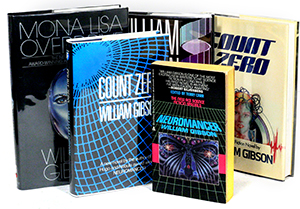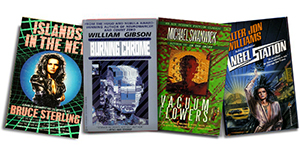 Without question, the birth of cyberpunk as a genre and a movement can be traced to a handful of reneged authors in the 1980s who grabbed hold of science fiction and injected it with a heavy dose of noir, surrealism, and punk rock edge. Picking up where the New Wave writers of the 60s and 70s left off, pioneers such as William Gibson, John Shirley, and KW Jeter dragged sci-fi, kicking and screaming, out of the ivory tower and down to the street level. If you truly want to understand what cyberpunk is all about, you need to start at the beginning. You need to start with the written word.
Without question, the birth of cyberpunk as a genre and a movement can be traced to a handful of reneged authors in the 1980s who grabbed hold of science fiction and injected it with a heavy dose of noir, surrealism, and punk rock edge. Picking up where the New Wave writers of the 60s and 70s left off, pioneers such as William Gibson, John Shirley, and KW Jeter dragged sci-fi, kicking and screaming, out of the ivory tower and down to the street level. If you truly want to understand what cyberpunk is all about, you need to start at the beginning. You need to start with the written word.
For this section novels have been divided into four distinct eras of cyberpunk fiction:
 PROTO-CYBERPUNK
PROTO-CYBERPUNK
Spanning from 1956 to 1975, these are the writers who paved the way for what was later to come. Some of their novels were ahead of their time, touching the core themes that would come to define cyberpunk literature. Prime examples are John Brunner’s Stand on Zanzibar and James Tiptree, Jr’s The Girl Who Was Plugged In. Although written a decade prior, both could be easily mistaken for products of 1980s cyberpunk. Meanwhile, authors like Alfred Bester, Harlan Ellison, and Roger Zelazny directly influenced books like Neuromancer, Hardwired, and City Come a-Walkin’. Sysop’s Note: No “Noteworthy Titles” are listed below since literally all of the Proto-Cyberpunk books are recognized as genre classics.
Classics:
• The Stars My Destination by Alfred Bester
• High-Rise by JG Ballard
• The Girl Who Was Plugged In by James Tiptree, Jr.
• Stand on Zanzibar by John Brunner
• A Clockwork Orange by Anthony Burgess
• I Have No Mouth, and I Must Scream by Harlan Ellison
• High-Rise by JG Ballard
• Do Androids Dream of Electric Sheep Philip K. Dick
• The Moon is a Harsh Mistress by Robert Heinline
• Damnation Alley by Roger Zelazny
 THE GOLDEN AGE
THE GOLDEN AGE
The First Wave of cyberpunk novels were published roughly between 1977 and 1997. While the First Wave is mostly associated with stories about high-tech burnouts in a neon painted futures, in actuality the Gold Age of cyberpunk was a far more freewheeling. Aliens, psychics, and hints of the paranormal were all present in those early days, a lot of experimentation. Alongside all the hard-edge tale about razor-girls and tech junkies were more experimental works such as Dan Simmons Hyperion Series. A re-imagining of the Canterbury Tales, Simmons envisions a 29th Century where AIs and modified humans have populated the galaxy. Early cyberpunk was also home to a unique breed of rock & roll fantasy that fell somewhere between magical realism and classic dystopian sci-fi–a genre John Shirley all but created with his City Come a-Walkin’ or which is only rivaled by Norman Spinrad’s Bowie-inspired Little Heroes. Another forgotten aspect of the Golden Age are more gonzo works, such as Rudy Rucker’s Wares Trilogy which reads like wholesale slaughtering of Asimov’s robots as told by Hunter S. Thompson.
Classics:
• Neuromancer by William Gibson
• Hardwired by Walter Jon Williams
• When Gravity Fails by George Alec Effinger
• Wetware by Rudy Rucker
• True Names by Vernor Vinge
Noteworthy Titles:
• Larissa by Emily Devenport
• Vacuum Flowers by Michael Swanwick
• Dr. Adder by KW Jeter
• Streetlethal by Steven Barnes
• Mindplayers by Pat Cadigan
 THE DIAMOND AGE
THE DIAMOND AGE
It is difficult to pin down exact dates when determining when a literary movement begins or ends. In the case of cyberpunk’s Second Wave, though, its inception undeniably was June 1992 with the publication of Neal Stephenson’s Snow Crash. At the time, cyberpunk was growing stale as book store shelves were growing crowded with juvenile fluff and second-rate William Gibson wanna-bees. Snow Crash was a shot of new blood and much need innovation. More importantly, Stephenson’s novel signified a course change in both writing style and attitude for cyberpunk. The door was now open to a new level of self-awareness, humor, and meta-fiction. New settings were introduced, far and away from the neon dystopias of the First Wave, whether it be the dreamspace of Jeff Noon’s Vurt, or the deep sea trenches of Peter Watt’s Rifters Trilogy. Most often, though, Second Wave novels occurred in a skewed version of the here-and-now, or in a future that were almost upon us. These is most visible in William Gibson’s Bridge Trilogy and Jeff Noon’s Nymphomation. Since it was Stephenson who mark the start of the Second Wave, I’ve dubbed it the Diamond Age, after Stephenson’s second novel.
Classics:
•Snow Crash by Neal Stephenson
• Vurt by Jeff Noon
• Virtual Light by William Gibson
• Fairyland by Paul McAuley
• Starfish by Peter Watts
Noteworthy Titles:
• Headcrash Bruce Bethke
• Shade’s Children Garth Nix
• Nymphomation by Jeff Noon
 THE CARBON AGE
THE CARBON AGE
The release of The Matrix in 1999 the film seemed the perfect bookend to a genre that was once again starting to look a bit long in the tooth. What better eulogy for the movement than a film that distilled all the best elements of the Diamond Age to a work of cinematic beauty, while simultaneous reducing it to a collection of action film clichés that would come to dominate the next decade? Likewise, the experimentation and broadening of the genre that defined the Diamond age also resulted in author moving further and further away from the core ethos of cyberpunk. Many exchanged the genre’s DIY punk ethic & “fuck you” attitude for whimsey and dandyism of steampunk or moved on to penning AI cyberthrillers and transhumanist space operas.
Then something interesting happened early into the new millennium. Classic cyberpunk started creep back into the public consciousness with the release of Richard K. Morgan’s Altered Carbon. Unlike prior generation of Second Wave authors, Morgan’s novel didn’t bother with such loft aim as re-defining the genre or showing us something new. No, Altered Carbon was beautifully crafted love letter to godfathers of cyberpunk. The book literally reads as a “best of…” collection of cyberpunk tropes, playing loving homage to Blade Runner, Neuromancer, Hardwired, and Ghost in the Shell….not to mention the plot plays like a high-tech Philip Marlowe story.
Third Wave Cyberpunk novels are defined by an unapologetic embrace of all things cyberpunk. Where are prior authors endeavored to innovate, this new generation approaches the genre as set of tropes, archetypes themes, and ideas—the key difference being these new writers just as influence by Japanese cyberpunk as they are the West cannon.
Classics:
• Altered Carbon by Richard K. Morgan
• Soda Pop Soldier by Nick Cole
• Black Glass by John Shirley
Noteworthy Titles:
• Nylon Angel by Marianne De Pierres
• Thirteen by Richard K. Morgan
• A Star Curiously Singing by Kerry Nietz
• Juarez Square & Other Stories by D.L. Young
• CTRL ALT Revolt! by Nick Cole

